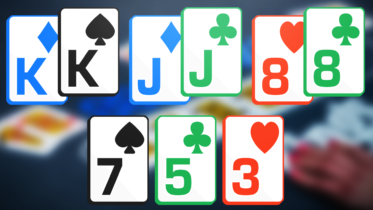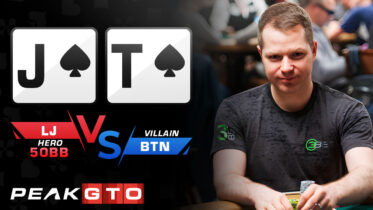Like most things in life, even a seemingly simple poker question can require dramatic refining and nuance before anybody can provide a useful answer. Thus, “How should I play an overpair, out-of-position (“OP”) in cash games?”, while a reasonable question, doesn’t have a simple answer.
In fact, rather than answer this question, I will propose some further questions that you should ask. The answers to these questions will guide you in deciding how to play in your particular situation.
But before we dive into the questions, there’s an unfortunate truth which we must accept:
Because we are out-of-position, we are at a disadvantage throughout the hand. This shadow will hang over every decision we make.
Okay, with that reminder, let’s push forward. How do we make the best of an inarguably bad situation?
4 vital questions to ask yourself when holding an Overpair in Cash Games
- How many opponents do I have?
- What is the stack-to-pot ratio (“SPR”)?
- Do I have the range and/or nut advantage with my overpair?
- How likely am I to have the best hand by the river?
How many opponents do I have?
The more opponents you have, the more passively and honestly you must play. Suppose you raise preflop from the UTG+1 position, and get three callers, all of whom will act after you post-flop. Let’s further stipulate that you manage to have an overpair after the flop. Note that I haven’t said whether you have K-K or 8-8. At some level, it’s not terribly important, because you have what Carlos Welch likes to call, “The second worst hand in poker – one pair.”
When you play a heads-up pot after the flop, the equity in the pot is shared by just two players. But with your three opponents, four of you are sharing the pot equity. Because we’ve stipulated that you have an overpair, you are currently losing to all hands two-pair or better. Of course, having K♦-K♣ on a Q♣-8♣-2♥ flop is much better than having 8♠-8♣ on a 6♥-5♥-2♥ flop, though both are “overpairs.” But even with the kings, you have to beat all three opponents to win the pot.
Furthermore, the opponent(s) with the strongest hand will be self-selected to continue putting money in the pot. So it’s as if all three of them are implicitly colluding to find the one who has the best chance to knock your cowboys off their horse.
The fact is that if you reach the flop 3-4 (or more) ways, one pair – even kings – isn’t much of a hand. It might still be good, but you’ll have difficulty knowing that, and particularly being out-of-position, you’re facing an uphill battle to get to a showdown.
The solution to this mess? Do a lot of checking, and when you do bet, bet small. The premium pairs often get us into the most trouble in these big multi-way pots because of “entitlement tilt.” That’s the idea that “dammit, our kings were the best hand before the flop, it’s been 90 minutes since I’ve seen a hand this good, and I am going to just bet it until everybody calls with worse or folds.”
But if one of your three opponents flopped two-pair, they don’t care that you had the best hand pre-flop, and they’re going to call all your bets.
A related phenomenon is the idea that you have to bet big to “protect” your hand. Let’s say that you raise K♥-K♦ UTG+1, and get three callers. The flop comes Q♠-8♥-2♠. A lot of players think, “Oh, I have to bet big to knock out the draws and protect my hand.” You should be more worried about protecting your stack. By betting big, you’re not protecting against straight and flush draws – you’re merely bloating a pot you aren’t favored to win, and setting yourself up for no-win decisions on later streets.
Accept that with an increasing number of people seeing the flop, the likelihood of you winning the pot goes down. Out of position, tread carefully, and be ready to get out when it becomes apparent that one of your opponents has passed you.

Make the best preflop decisions with Jonathan Little’s Push/Fold Charts!
What is the current stack-to-pot ratio (SPR)?
The SPR is simply the ratio between the effective remaining stack and the size of the pot. If there’s $60 in the pot, and the shortest remaining stack is $150, then the SPR is 2.5. As the SPR shrinks, the value of a single pair, while it is still the second-worst hand in poker, goes up dramatically. Let’s look at a couple of extreme examples:
Low SPR in Cash Games– stick the money in and see who wins
You’re playing $1/3 NLH. A player in early position raises to $12, and gets four callers (this isn’t as rare as you might think). You find K♣-K♦ in the small blind, and make it $100 (a quite reasonable raise). Everybody but a cold-caller in the lojack folds, creating a pot of about $250. By the way, congratulations on your raise sizing – narrowing the field from six to two is a huge win. You had started with $300, and now have $200 behind. The single caller started with $300 as well. So the SPR is 0.8 going to the flop, which is J♠-4♦-T♠. There are various ways of getting the money in, but you are never folding.
You may be the one who drives the betting, or your opponent may do it. Stacks may go in, or not. But whatever happens, do not fold your kings in a heads-up pot that saw a jack-high flop with an SPR of 0.8.
High SPR in Cash Games– tread cautiously
Now, let’s revisit this same hand, but we’re going to move you and all your table-mates to Texas. Everything is the same, except, because Texas, everybody started with $1500 instead of $300. There’s the same preflop action, the same J♠-4♦-T♠ flop comes down, and you have the same overpair of kings, but now the SPR is 5.6. If all remaining $1400 from each of the two remaining players goes into the middle, either your kings are crushed by a set or two-pair, or you are in a dead heat against a hand such as A♠-Q♠. Furthermore, your hand has little opportunity to improve – an overpair usually arrives at the river as one pair.
Deeper stacks favor the in-position (IP) player, so when you’re OP, an SPR of 5.6 is a huge disadvantage for you. You might choose to check this flop and “play from the defensive side of the tree,” as the theorists put it. That is, acknowledge your disadvantage in the situation, and at least initially, let your opponent do the betting. If they check back the flop, then the balance of power has swung back toward you and you can begin betting.
Even if they do bet, that’s not the end of the world. By checking, you’ve under-represented the strength of your hand, and potentially induced bluffs and value bets from weaker hands, such as Q-J. You can now profitably call down with your kings on many run-outs.
But that said, when stacks are deep, a hand that was clearly best preflop is now on unstable ground and must proceed carefully. Bluntly put, there will be many run-outs where you have to fold your overpair at or before the river.
Do I have the range and/or nut advantage with my overpair?
Think back to the preflop action, and consider the board texture. The whole topic of range/nut advantage is far too complex to review here, but some boards favor the preflop raiser (or 3-bettor), while others favor preflop callers (or a raiser who called a 3-bet). If you have the range and nut advantage, you can bet more frequently.
Suppose you are playing $2/5 NLH and open K♠-K♥ in the UTG+1 position to $20. Only the hijack player calls. The flop comes 7♥-6♦-3♦. You still have the range advantage, because you can have all the big pairs (e.g. JJ+) and your opponent would have normally 3-bet those. However, your opponent has the nut advantage, because they can have hands such as 5-5, 3-3, and the occasional 7-6 or 5-4 suited – you rarely have those hands.
Not all of your opponents will be able to recognize the nut advantage that they have with this flop, but those that do can put you in some rough spots. If you bet big and get raised, your opponent is threatening to put entire stacks in the middle – you do not want to play for (e.g.) 150 BB stacks with pocket kings on this board.
While you can’t “pot control” from out-of-position (your opponent always has the option of putting money in on this street), you can choose to not bloat the pot, and see if and how much your opponent wants to bet.

Read one of the highest regarded articles on the PokerCoaching.com blog: The Bankroll Bible
How likely is my hand to remain strong by the river?
The title of this article is about “playing overpairs out of position.” However, the elephant in the middle of the room is that not all overpairs are created equal. I alluded to this elsewhere, but this question shines a light on the elephant. If you have Q-Q on a T-7-3 rainbow flop, there’s a “decent” chance that your pocket queens will still look fairly strong by the river. No promises, of course – poker is short on those – but you might get two, perhaps three streets of value from your hand.
Conversely, suppose you have 8♥-8♣ on a 7♦-5♦-2♠ flop. Sure, you have an overpair, but it’s long odds against you feeling great about your hand by the river. Cards lower than your eights all but promise straights and two-pairs. Cards above your eights – well, you know the problem with those. And a diamond could easily spell doom.
Somewhat counter-intuitively, you might choose to bet the 8-8 more frequently than the Q-Q, simply because it benefits more from getting value now and protection than the queens do. However, the admonition to bet small still holds – if you bet, you must bet small.
Acknowledge that you’re on the defensive
The most important thing you can do to play overpairs well when out-of-position is to acknowledge two important weaknesses in your situation:
- You have one pair, and
- You’re out of position
Particularly with the big premium pairs, these can be two hard pills to swallow, but swallow them you must. Once you’ve done that:
- Answer the questions above to understand your situation as well as possible.
- How many opponents do I have?
- What is the stack-to-pot ratio (“SPR”)?
- Do I have the range and/or nut advantage?
- How likely am I to have the best hand by the river?
- Check frequently.
- When you do bet, bet small – think B20 as a starting point.
- Admit that you will frequently be folding at or before the river – even hands which were inarguably best before the flop.
In closing, let me leave you with a sobering screenshot from GTOWizard. This is a solution for a situation where you have raised in the UTG position, and been called by the cutoff. The flop is 7♥-6-♦-3♦. The equilibrium solution has you checking 94% of the time. It would be perfectly reasonable to “check range” here – that is, check all your hands. Even our example premium hand – K-K – is checking 88% of the time.
Even the Machine, which knows nothing of fear or anxiety, is keeping its head down. Let that be a lesson to you as you navigate the choppy waters of an overpair, out of position.




